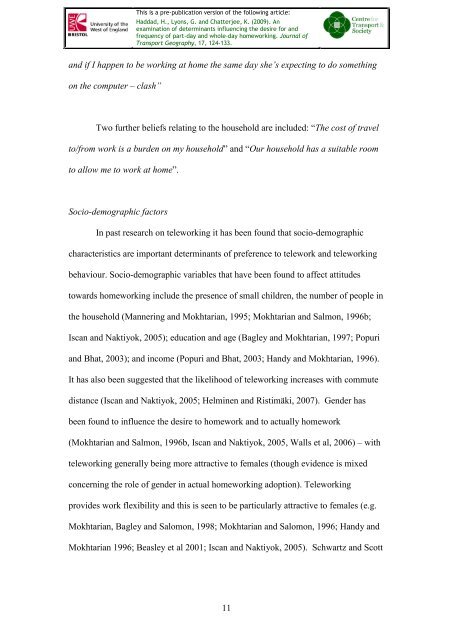Haddad, H. , Lyons, G. and Chatterjee, K. (2009) - UWE Research ...
Haddad, H. , Lyons, G. and Chatterjee, K. (2009) - UWE Research ...
Haddad, H. , Lyons, G. and Chatterjee, K. (2009) - UWE Research ...
Create successful ePaper yourself
Turn your PDF publications into a flip-book with our unique Google optimized e-Paper software.
This is a pre-publication version of the following article:<br />
<strong>Haddad</strong>, H., <strong>Lyons</strong>, G. <strong>and</strong> <strong>Chatterjee</strong>, K. (<strong>2009</strong>). An<br />
examination of determinants influencing the desire for <strong>and</strong><br />
frequency of part-day <strong>and</strong> whole-day homeworking. Journal of<br />
Transport Geography, 17, 124-133.<br />
<strong>and</strong> if I happen to be working at home the same day she’s expecting to do something<br />
on the computer – clash”<br />
Two further beliefs relating to the household are included: “The cost of travel<br />
to/from work is a burden on my household” <strong>and</strong> “Our household has a suitable room<br />
to allow me to work at home”.<br />
Socio-demographic factors<br />
In past research on teleworking it has been found that socio-demographic<br />
characteristics are important determinants of preference to telework <strong>and</strong> teleworking<br />
behaviour. Socio-demographic variables that have been found to affect attitudes<br />
towards homeworking include the presence of small children, the number of people in<br />
the household (Mannering <strong>and</strong> Mokhtarian, 1995; Mokhtarian <strong>and</strong> Salmon, 1996b;<br />
Iscan <strong>and</strong> Naktiyok, 2005); education <strong>and</strong> age (Bagley <strong>and</strong> Mokhtarian, 1997; Popuri<br />
<strong>and</strong> Bhat, 2003); <strong>and</strong> income (Popuri <strong>and</strong> Bhat, 2003; H<strong>and</strong>y <strong>and</strong> Mokhtarian, 1996).<br />
It has also been suggested that the likelihood of teleworking increases with commute<br />
distance (Iscan <strong>and</strong> Naktiyok, 2005; Helminen <strong>and</strong> Ristimäki, 2007). Gender has<br />
been found to influence the desire to homework <strong>and</strong> to actually homework<br />
(Mokhtarian <strong>and</strong> Salmon, 1996b, Iscan <strong>and</strong> Naktiyok, 2005, Walls et al, 2006) – with<br />
teleworking generally being more attractive to females (though evidence is mixed<br />
concerning the role of gender in actual homeworking adoption). Teleworking<br />
provides work flexibility <strong>and</strong> this is seen to be particularly attractive to females (e.g.<br />
Mokhtarian, Bagley <strong>and</strong> Salomon, 1998; Mokhtarian <strong>and</strong> Salomon, 1996; H<strong>and</strong>y <strong>and</strong><br />
Mokhtarian 1996; Beasley et al 2001; Iscan <strong>and</strong> Naktiyok, 2005). Schwartz <strong>and</strong> Scott<br />
11

















